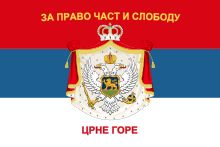Montenegrin nationalism
[8] After 1998, Montenegro's government led by Milo Đukanović demanded greater autonomy within the Federal Republic of Yugoslavia.
The early postwar period was characterized by intense armed struggle within Montenegro, economic marginalization and the formation of new political parties.
Hence, not just the kinship, but the identity of certain cultural forms among the Dinaric peoples, all the way from Albanians to South Tyroleans, who are Germanized Illyrians.
Most importantly, the Montenegrin communists dropped their initial commitment to Yugoslav unitarism, instead embracing Lenin’s principle of self-determination.
Thus, the Montenegrin communist party began its struggle for an "independent Soviet Republic of Montenegro as part of the future Balkan Federation".
The party attracted the support of many Greens and, in the 1920 elections, won 37.99 per cent of the popular vote in Montenegro, which would influence its later commitment to recognizing Montenegrins as a separate nation.
[11] Democracy was proving to be unworkable in Yugoslavia, and King Alexander imposed the 6 January Dictatorship in 1929, following a series of grim events including the murder in parliament of Croatian Peasant Party leader Stjepan Radić in June 1928.
[9] Following the April War and the occupation of Yugoslavia by the Axis forces, nationalist Montenegrin Federalist Party offered to collaborate with the Italian Fascists, demanding a "Greater Montenegro" from Neretva river in Herzegovina to Mata in Albania; it would also include Metohija and Sandžak.
A much smaller "Kingdom of Montenegro" was proclaimed on Saint Peter's Day Assembly on 12 July 1941, with the territorial claims of the Ustaše and Albanians being relatively more favoured by the Nazis.
The restored Montenegro lost Metohija and its eastern lands to a Greater Albania, but managed to gain the Serbian part of Sandžak.
A number of Montenegrin Federalist Party members, headed by Novica Radović, opposed this decision, because the territorial claims were not accepted and it failed to reinstate the Petrović-Njegoš dynasty.
[12] Only a day after the puppet state of Montenegro was proclaimed, Partisans staged the 13 July Uprising, and the Montenegrin Federalist Army went to exile.
[14] Serbian and Montenegrin reservist soldiers from the JNA entered Herzegovina in September 1991 in preparations for an attack on Dubrovnik.
[17] Dissatisfaction with perceived domination from Serbian circles resulted in Montenegrin nationalism becoming a strong movement in Montenegro.
Similar to the violence between the Greens and the Whites after World War I, violent confrontations occurred between supporters of Đukanović and pro-unity President Bulatović.
[4] James Minahan claims that the causes that resulted in the development of contemporary Montenegrin nationalism have been dated back to the mid-14th century when Montenegro first became a sovereign state.
In March 2004, the Montenegrin education council proposed changing the official language of the republic from Serbian to Maternji jezik (mother tongue).
The proposal caused outrage among ethnic Serbs, who saw it as an attempt by the Montenegrin government to marginalize aspects of Serbian identity.



